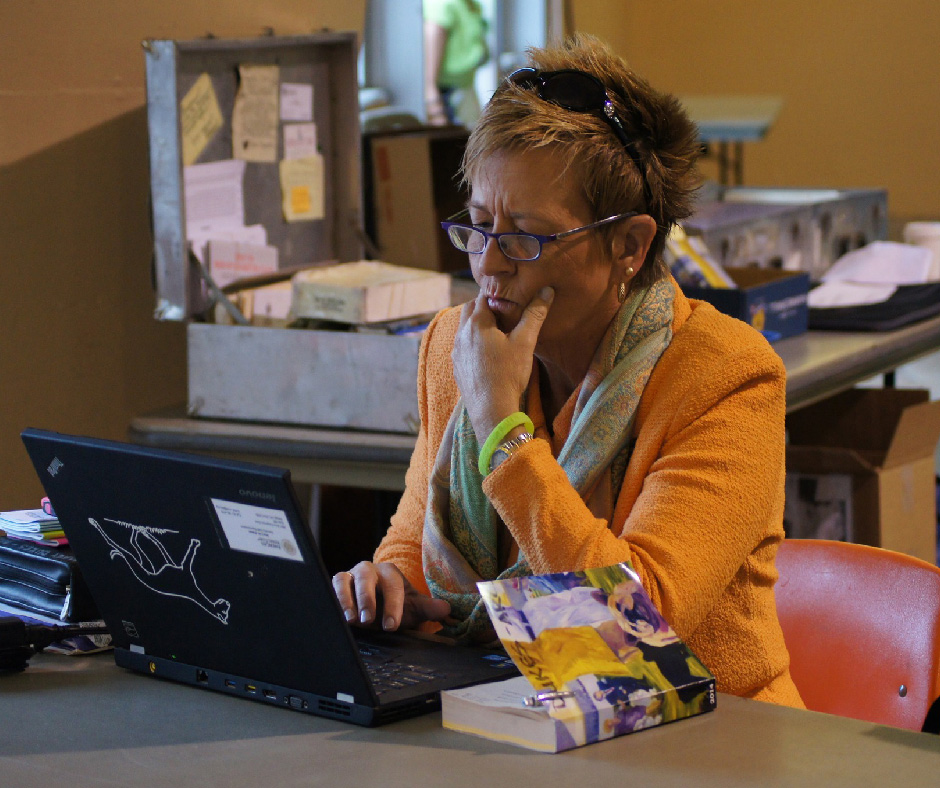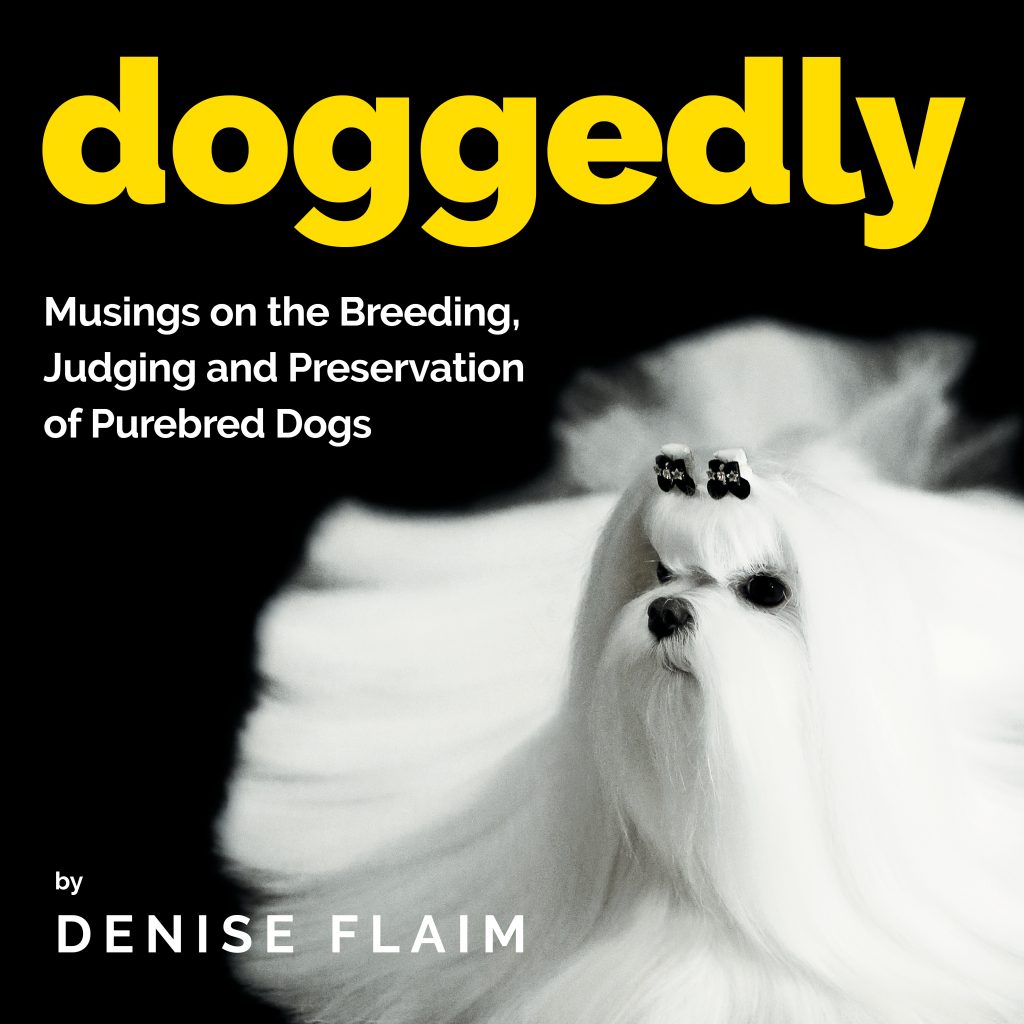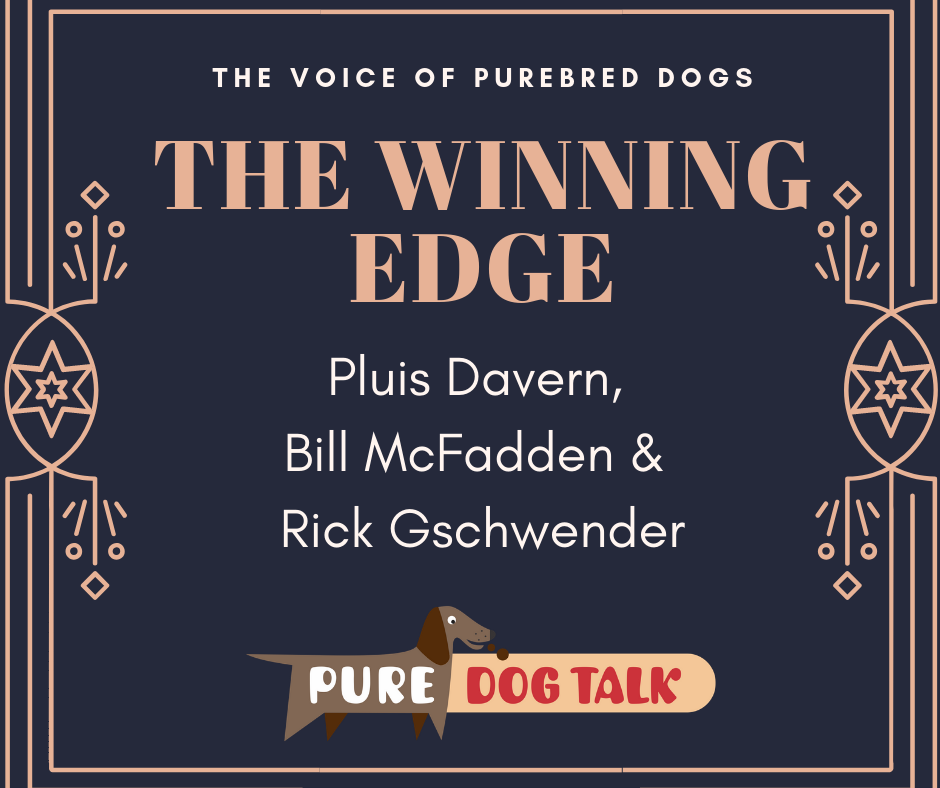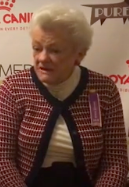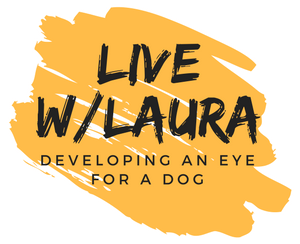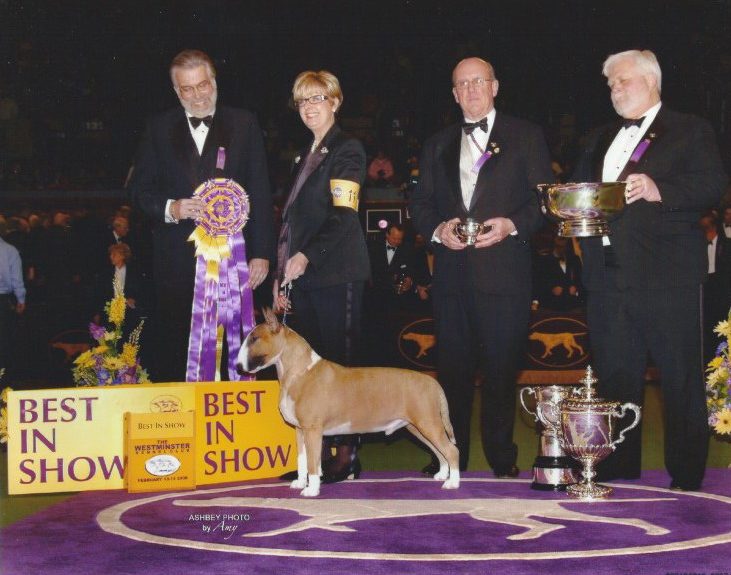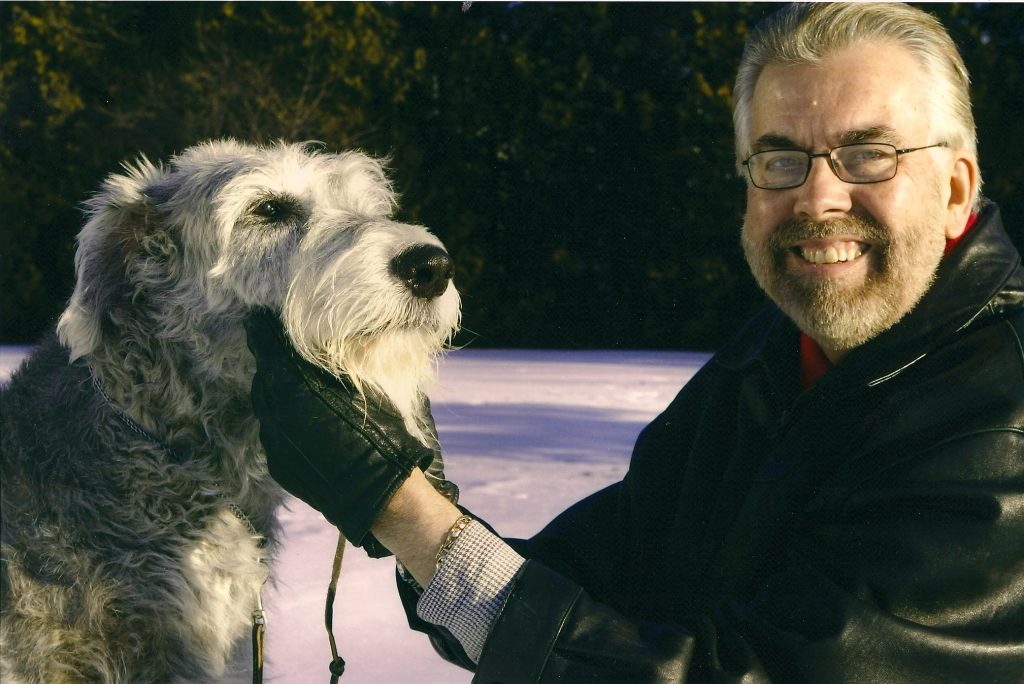616 – Mary Dukes: An Evolution from Owner to Professional to Rep to Judge
Mary Dukes: An Evolution from Owner to Professional to Rep to Judge
Host Laura Reeves is joined by Mary Dukes, legendary Whippet breeder, professional handler, AKC Executive Field Representative and now judge.
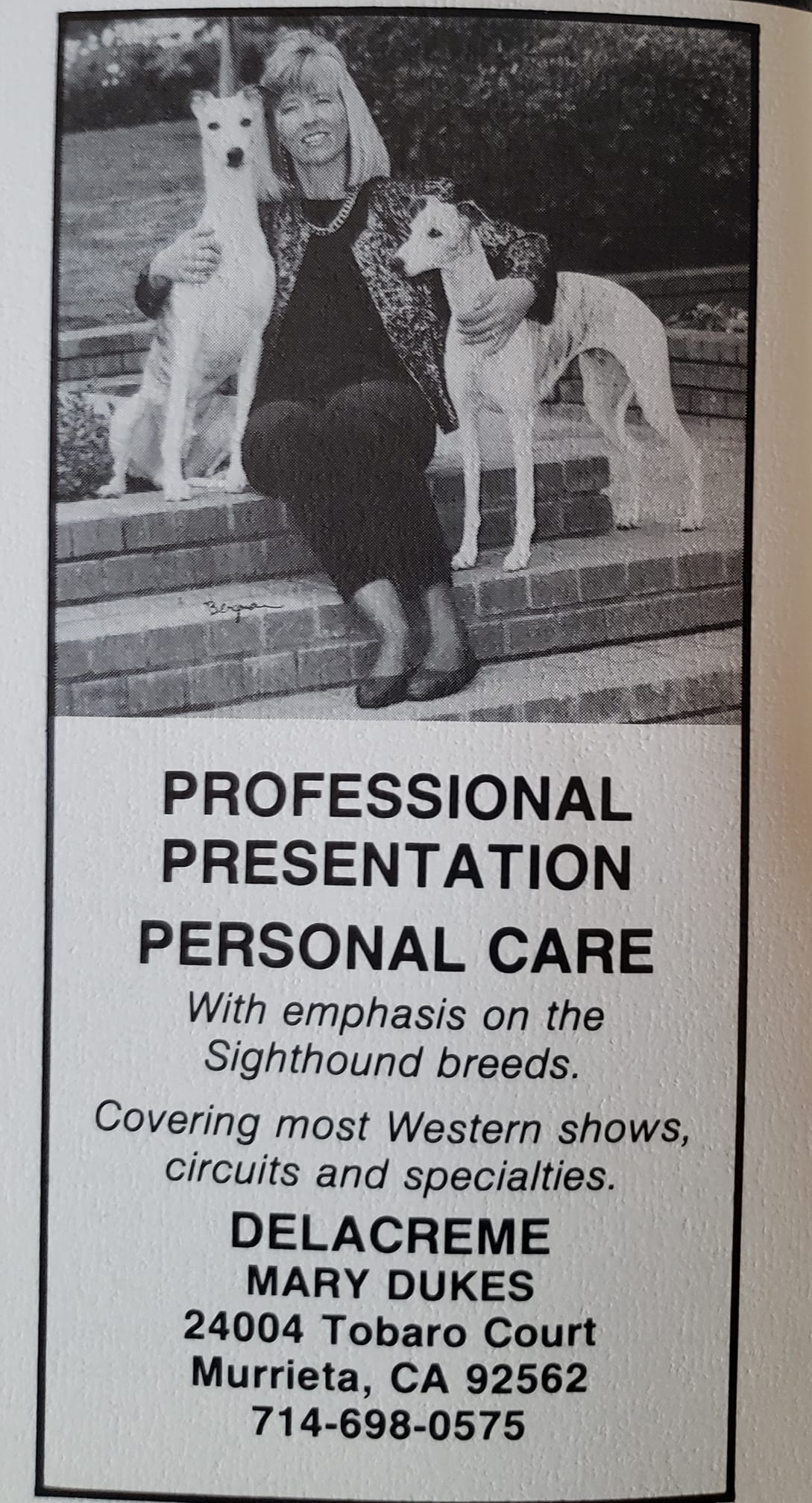
A 1991 advertisement for Dukes’ handling services.
Dukes has spent a lifetime involved in working with animals. From showing horses to training elephants to showing dogs. Her work with the zoo animals instilled in her an absolute dedication to animal husbandry.
NO Dirty Dogs
“There are no shortcuts in animal care. Period,” Dukes said. “In zoo animals, you have to be even more on top of it because wild animals don’t have a tell that they’re sick. In the wild, any tell that they are sick or injured is going to make them dead. So they are really good at masking that. If you are sloppy or dirty or messy there is no room for you in the animal business.
“I’ll put this on blast right now, if someone walks into my ring with a dirty dog, we’re going to have a problem. There is no excuse to show a dirty dog. I won’t hold it against the dog, but the handler might get an earful.”
AKC Registered Handler Program
Dukes was an early member of the AKC Registered Handler Program. As a rep, Dukes was a coordinator of the RHP. She joined RHP because they demanded insurance, inspections, so “I wanted to put my money where my mouth was.”
RHP is not a guarantee the handler is going to win with your dog, Dukes said.
“The whole point of the program is so the people have a place to start looking where we had done some of the ground work for you. You know they (they handlers) are insured. You know their vehicle is inspected for safety and cleanliness. You know their kennel has been inspected by AKC kennel inspectors. You know they’ve signed a code of ethics.
“RHP members have to have a contract. They have to bill in a timely fashion. The bill has to be itemized. A lot of the trouble you see, most of it is because the expectations weren’t clear. If you have a contract, it’s
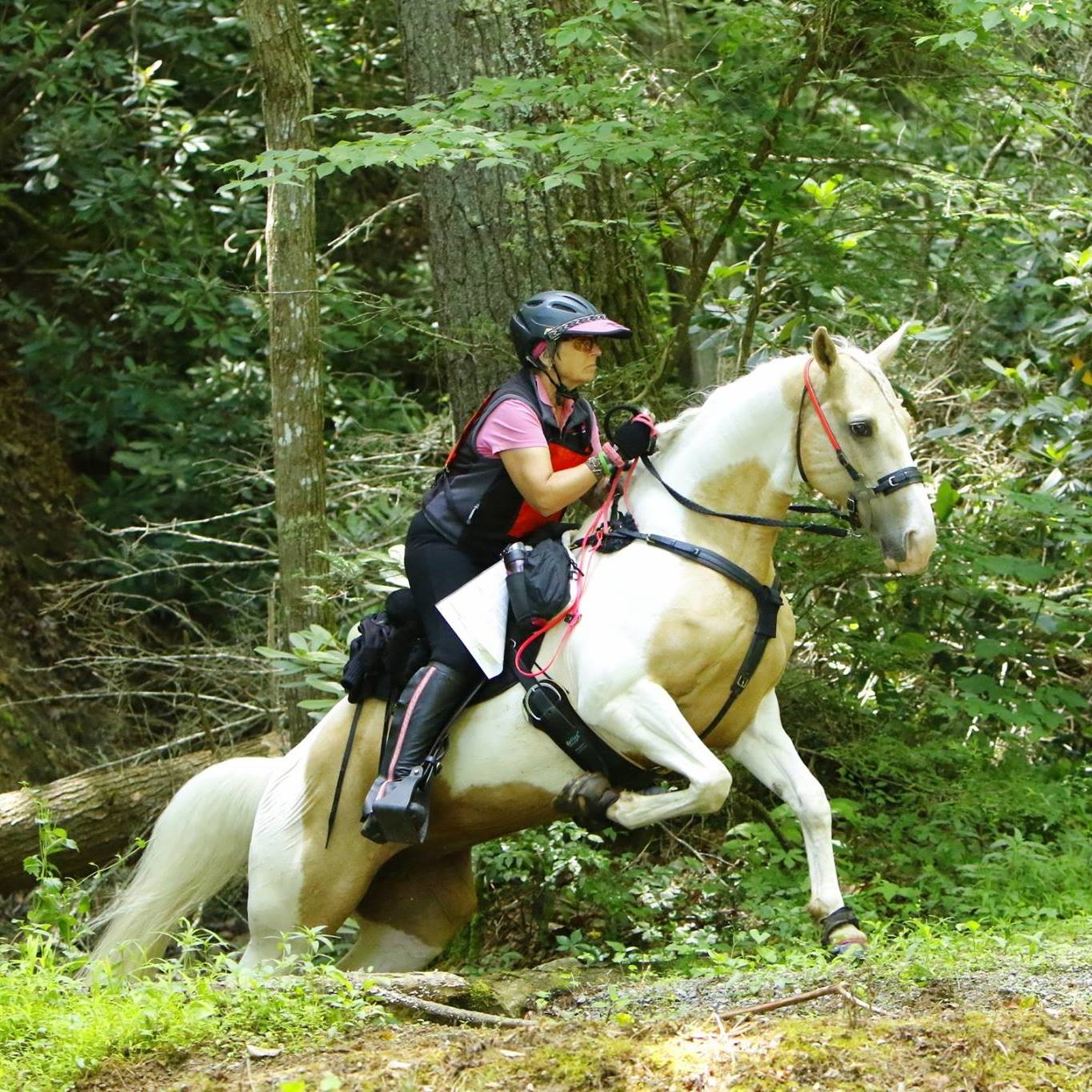
Dukes is still actively involved with horses. Her vacations frequently involve riding in exotic locales.
right there in black and white.
Safe Sport
“One of the newest requirements is SafeSport. All RHP members have to take the training as a condition of membership.
“Safe Sport is a congressionally mandated program for every Olympic sport.
“There’s been a lot of abuses in every sport. Basically, Safe Sport is making you aware of what to look for. If you see a situation that you suspect might be something, it gives you tools. Because we aren’t an Olympic sport, we don’t have access to the mechanics of the national organization.
“It automatically makes everyone (who’s had the training) mandatory reporters. If you put it out in the open more, it’s harder for someone to creep around. I would like to see it spread out to judges, especially juniors judges.”
Join us next week for part two of this fantastic conversation. Learn what Dukes is looking for in a dog and hear about her fantasy Best in Show lineup.
427 – The Road to Center Stage
Road to Center Stage: Panel Discussion on the Process to Become a Judge
Throwback to a Friday Night Forum when we could all go to dog shows. Bryan Martin reviews the judging application process that was put in place most recently. Martin gives a thorough overview of the various systems that preceded the current updates. (Note: This event was held prior to 2020 and the temporary changes/revisions applied to this process due to the Pandemic).
Anyone beginning the judging process or moving forward will find this useful. Exhibitors will be able to understand the requirements for the judges in the center of the ring.
AKC judges Brian Meyer and Sylvie McGee share their experiences, what drives them to judge, what they enjoy and what frustrates them. This valuable input helps exhibitors understand that the judge in the ring was not hatched from an egg.
Meyer says that finding the dog nobody else has found is part of his joy in judging. “Maybe it’s a puppy dog, maybe it’s a puppy bitch. I don’t care. I really don’t care what class it came from. It could be a novice person that doesn’t really have any idea what they’re doing. You’re not judging their ability. You’re judging what the dog is supposed to look like according to the standard.”
His frustration? “You use the same pattern all day long. And your last breed of the day. Your last class of the day, the person looks at you and goes ‘did you want me to make a triangle?’ when you been going down and back all day. I mean, you have to watch what a person is doing before you walk into the ring to prepare yourself.”
McGee notes her enjoyment of assisting new handlers and her frustration at dirty dogs.
“I love the dogs,” McGee said. “I love everything about judging really. I love it when novice people come to the ring … if I could give him some encouragement or maybe say ‘you know let’s move that dog one more time maybe you could loosen up that lead a little bit.’ That’s a gift to them and it helps me to see the dog better.”
“I think if you talk to any judge, dirty dogs (are a frustration),” McGee said. “So imagine you’re the judge, standing in the middle of the ring, everyone is watching you, and you’re thinking to yourself ‘do I dare, now that I’m going over this dog who is filthy, go over and visibly use a handiwipe or use hand sanitizer before I touch this next exhibit because I don’t want to transfer whatever I just picked up on my hands. Please bathe your dogs.”
Meyer adds one important note of emphasis.
“You, as exhibitors, are not necessarily the most compassionate people with new people. Yeah, I’m going to put some of that on you people because you’re the ones that should be helping these new people that are coming in …”
To watch the video from this event, click here.
396 – “Doggedly” Pursuing Preservation of Purebred Dogs
“Doggedly” Pursuing Preservation of Purebred Dogs
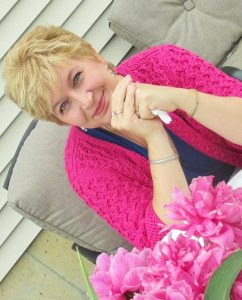
Author, Editor, Breeder, Judge Denise Flaim.
Host Laura Reeves and Denise Flaim, author of “Doggedly: Musings on the Breeding, Judging and Preservation of Purebred Dogs,” cover a lot of ground in their own musings on these topics.
What do respect, breed standards, judging, cooking, jazz music, period furniture and museums have in common? Listen in to this wide-ranging and challenging discussion for the answers.
“I think the way you learn a new breed is a three part process: head, heart, gut,” Flaim said. “First you see the breed. You know it exists. You start to study it. You read the standard. You go to seminars. It’s in your head.
“You have all those pieces, but there has to be something that you connect with with that breed. Maybe you met one and just sort of fell in love. Maybe it’s closely related to the breed you started with or breed that you really like. There’s got to be something that moves that breed from your head into your heart so that you genuinely like it.
“Then you’ve got that motivation to learn more about it. Slowly, as you get more exposure and you get more depth, and you talk to breeders and you talk about the stuff that the standard doesn’t say but that you as a judge need to know, it goes into your gut.
“That’s, I think, a big part of judging that people don’t talk about is instinct. Your gut feeling. It’s not just like some muse descends on you from out of nowhere that gut feeling comes from the drip drip drip of knowledge that you’ve gotten an exposure and then suddenly you don’t have to think.”
“Doggedly” reading
“It’s a real kind of buffet of ideas about dogs,” Flaim said. “A lot of times we talk about individual dogs and a lot of times we talk about very specific surface things but not as often as I would like do we talk about the ideas and the thoughts behind them.
“The thing I really am most proud about this book is, if you’re somebody who really is into dogs in more than a surface way, Pat Trotter said that she read it, she’s up all night. So I think of it as the book that keeps Pat Trotter awake at night.”
“Doggedly” is available at www.revodanapublishing.com. Use the code PUREDOGTALK for $5 off on any book.
Learn more:
223 — Rhodesian Ridgeback: Power and Elegance | Pure Dog Talk
294 – Veterinary Voice: Brachycephalic Breeds’ Health and Legislation | Pure Dog Talk
361 – Specialty vs All Breed Part 2: Identifying Solutions
Specialty vs All Breed Part 2: Identifying Solutions
Our experts are back to help us identify solutions to the dilemma of specialty versus all breed shows. Part one is available for listening here.
All breed shows offer a moderating influence on the extremes that can reign at specialty shows. They also enable judges and owners to see the quality of dogs presented at specialties.
“The ultimate learning tool for judges is to get your hands on good dogs.”
And, in a special opportunity, I had a listener contribute thoughts on this topic that I think are absolutely on point and applicable to this conversation. Welcome Tracy Dineley, Clandara Perm Reg, with her input.
“I just wanted to write to you after listening to your latest podcast as this topic has been on my mind for the last few years and I myself have spoken about it many times and have also written about it.
First let me give you my 411. I have been involved in purebred dogs since 1981 as a professional handler and breeder exhibitor. I have been breeding and showing Staffordshire Bull Terriers since 1984. I have bred more all-breed BIS dogs than any other breeder in Canada and more National Specialty winners in Canada than any other breeder. I have over 80 champions in Canada and the US.
It is my opinion that showing strictly or mostly at one or the other, specialties versus all breed shows is actually detrimental to any breed. It divides a breed, usually not for the better, in two directions. In some cases, it has divided breeds to the point that they almost end up looking like two different breeds.
All breed judges versus breed specialists have different priorities when judging. An all-round judge will judge the whole dog. They won’t focus on one thing. They take soundness and movement into the equation. They may even refresh themselves with the breed standard.
The breed specialist judge tends to focus on types or heads. They forgive movement flaws and sometimes forgive to the point that they will put up maybe a pretty or typey dog that is just plain unsound. They might even focus on things that are an issue in their own breeding program. It is not always the most balanced opinion.
In my breed, I have found that many breed specialists will interpret the breed standard to suit themselves. For instance, the breed standard calls for a level topline, but many breeders say that level doesn’t really mean level. I also find that many specialty winners cannot win at the all-breed shows at a high level. I think it’s usually because they are not sound enough. Just the same as some top-winning BIS winners who cannot win a Specialty. They are not typey enough.
In my opinion, we should all be striving to win under both judges. To have a dog that is correct and typey enough to win a specialty and sound structurally correct enough to win under all-rounders at all breed shows.
I think your speakers on the podcast were perfect for this topic. I think out of the three breeds, Staffy Bulls, Collies, and Bull Terriers, the Bull Terriers are the only breed that has it right. I believe you could take pretty much any specialty-winning Bull Terrier and do some serious winning at the all-breed shows even to BIS level.
I think the possibilities of creating extremes happen on both sides and therefore are detrimental to any breed. We need balance. We should always strive for the best to be somewhere in the middle of extremes but have the best of both worlds.
Thank you for your podcasts, I look forward to them every week!”
322 – The Winning Edge! Panel Discussion With the Masters
The Winning Edge! Panel Discussion With the Masters
Host Laura Reeves moderates a Friday Night Forum Panel Discussion on the topic of the “Winning Edge” with Judges Rick Gschwender and Pluis Davern and Professional Handler Bill McFadden.
It is not the judge’s job to find a “diamond in the rough,” Reeves posits. “Polish your “gem stone” for your best chance of success.”
Good habits
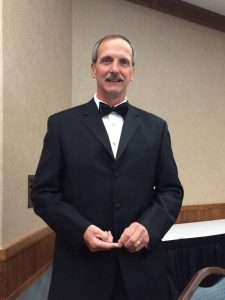 Gschwender starts the discussion by asking the audience about their habits with the dogs they exhibit.
Gschwender starts the discussion by asking the audience about their habits with the dogs they exhibit.
“How many of you train your dog? Road work him? Take video to see what the judge sees? Clean their teeth?” Gschwender queried. “I see people all the time, they’re paying $30 to enter the dog and haven’t even cleaned teeth.”
Gschwender adds, “Watch the judges. If you pay attention, you will see consistency in what they put up. You might not like it, but you will figure out what I like and come back and show that to me.”
Motivated by motion
Davern noted, in a fascinating observation, that people are *predators.* Which means “we are motivated by motion. What are judges looking at?” Davern asked rhetorically. “Motion. It catches the eye. You can *subtly* move your hand to show a pretty head, for example.
“You’re in the ring, you’re all showing the same “product.” There’s 20 boxes of cornflakes. What makes yours better than the others?”
Owner handlers have a huge advantage, Davern said. They are spending time with the dog they love.
“This is a great sport! Nobody takes a golf club to bed at night,” Davern said. “Life is not all about winning.”
Be prepared
“Take a deep breath and don’t rush,” McFadden advises. He also notes that in some cases, owner handlers who are long time breeders are “experts showing to novices.” Judges are life-long learners and may be new to a breed. “Present your breed the way it should be shown.”
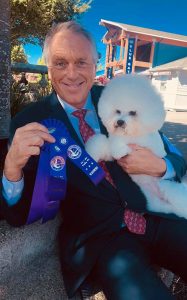 Most importantly, McFadden said, be prepared. “Make sure your dog is in condition, physically, mentally, emotionally.”
Most importantly, McFadden said, be prepared. “Make sure your dog is in condition, physically, mentally, emotionally.”
“You’ll have successes and failures you deserve and ones you don’t. It happens to handlers too. We show 20 dogs and might win with two,” McFadden added.
For more insight from a couple of these panelists, you can listen back to:
https://puredogtalk.com/10-bill-and-taffe-mcfadden-live-at-akc-nationals-wisdom-wednesday-2/
https://puredogtalk.com/34-sussex-spaniels-hunt-tests-search-and-rescue-pluis-davern-tells-all-2/
https://puredogtalk.com/35-dogs-to-the-rescue-firefighters-first-responders-and-pluis-davern-2/
256 — Jason Hoke: Just Judge the Dogs & Be Nice to People
Jason Hoke: “Just Judge the Dogs & Be Nice to People”
Second generation dog breeder Jason Hoke grew up with German Shepherd Dogs. His family acquired Great Danes in the mid ‘80s and he now owns Whippets.
“I think when I judge dogs, I’m very much a purist,” Hoke said. “I think handlers revert back to being even harder and more like a breeder judge. Because we were handlers, we know the value of showmanship, but also realize flash and dash doesn’t make a good dog.
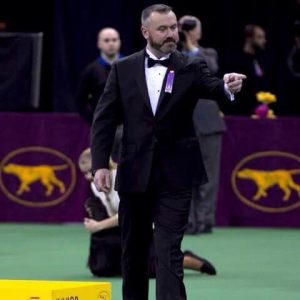
Jason Hoke judging at Westminster Kennel Club
“Just judge the dogs,” Hoke said. “That’s the best thing we can do.”
Breeder judges and handler judges
“As handlers, we have the opportunity to put our hands on so many more breeds,” Hoke said. “To be a successful handler, you have to learn what a good dog is in every breed you show. But at the core, we’re still breeders. We care about the breeds.
“I don’t care if it moves on the table, stands like a statue, comes back and does the pose heard round the world, if it’s not a good dog, just being a good show dog doesn’t make it a good dog,” Hoke said.
Pet peeves
“Running like a maniac around the ring is ridiculous,” Hoke said. “It defeats the purpose. It takes away from the dog’s silhouette and ruins every part of the outline. Showing a dog like a generic dog is incorrect.”
Encourage new people
“We have to be accessible, open to talking to new people,” Hoke said. “Encourage new people. Be members of clubs to volunteer. We have to teach people what our breeds are all about.”
BIO, from Petcha:
“Jason M. Hoke, a resident of Madison, Wis., began his longstanding involvement in the sport of purebred dogs in the late 1970s exhibiting German Shepherd Dogs in Junior Showmanship. In 1984, he and his parents purchased two Great Danes, which became their passion. They bred Great Danes under the Jamara prefix, producing numerous champions and one of the top Great Danes in the breed’s history.
Mr. Hoke continued his involvement by apprenticing as a young adult with noted professional handlers such as Leroy Stage and Wood Wornall. He then went on to become a successful professional handler, winning Best in Shows from many groups, and presented dogs to the highest rankings in their respective breeds.”
Quote of the Day, From Great Dane Review:
What advice would you give owner handlers just getting started in the ring?
Since I started as an owner handler I think the biggest suggestion is first to study the breed. Learn the Trends and Lines. Then while you are in the ring and outside, observe all the dogs. Be objective and try to see where your dog falls in the mix. Be fair when thinking about your own dog. Know it’s strong points and it’s weaknesses as well. Always try to accentuate the positive of your dog. Listen to others for tips as well. Most people will try to give you constructive advice. Mentors in the breed are invaluable from a breeding and a handling standpoint. Practice handing and go to handling classes. I used to go to classes 2 times a week for years. It’s a great training tool for your dog as well as yourself.
222 — Lydia Hutchinson on Cairn Terriers and 54 Years Judging
Loving life and living for Cairn Terriers
I visited with Lydia Hutchinson, renowned AKC judge and breeder, owner, handler of Wolfpit Cairn Terriers, at Westminster Kennel Club earlier this year. After a day of stewarding, this enthusiastic septuagenarian was bubbling with enthusiasm about pedigrees, breeding and the sport of conformation dog shows.
Watch the video.
A lifetime in dogs
“I wasn’t quite born in to (dogs),” Hutchinson said, “But my parents got their first Cairn Terrier two months before I was born.”
Following a familiar path, Hutchinson and her family eventually wound up at a dog show. The year was 1949 when she attended her first dog show “when I was 9 years old.”
In the intervening 70 years, Wolfpit Cairns have produced 270 champions, Hutchinson said, almost exclusively homebred and largely owner handled.
Breeding, handling, judging
Hutchinson is still actively breeding and showing her Cairns. She said showing and judging dogs at the same time maintains her sensitivity to exhibitors, keeps her up to date and “keeps you young.”
Cairn Terriers are a breed noted for their adaptability, alertness and independence, Hutchinson said. She calls Cairn grooming for the show ring, “achieved naturalness.”
As she developed the family’s Wolfpit line of Cairns, Hutchinson said she utilized principles of line breeding learned from early Poodle mentor. She imported bitches from Europe looking to improve coats and fronts, but building on her program’s established sire line.
“I still hand-write pedigrees,” Hutchinson said. “I know it’s old-fashioned, but it helps solidify the pedigree in my mind.”
Hutchinson started judging in 1964 “when I was 7 months pregnant with our second child. She judges terrier, toy, herding, poodles, schnauzers. She noted that she wants to “have a relationship with a particular breed to want to judge them.”
“There is not a dog show I go to that I don’t learn something,” Hutchinson said. “Using your eyes, asking questions of knowledgeable people, you’ll learn.”
There’s something about the sport of dogs that’s very energizing, Hutchinson observed.
“I love life, I love my dogs. I’ve been married to my husband for 57 years. I’m not tired at all! I’m looking forward to tomorrow.”
177 — Developing An Eye For a Dog: Recorded LIVE
Developing An Eye For a Dog: Recorded LIVE
San Mateo Kennel Club invited PureDogTalk to sponsor a live expert roundtable at its all-breed show in March. Exhibitors who participated were treated to a rare opportunity to interact directly with some of the most knowledgeable people in the sport. Judges Pat Trotter, Desmond Murphy, and Ken Murray were joined by professional handler Andy Linton to address the topic of developing an eye for a dog and answer audience questions.
“Lifers” Share Their Knowledge
These folks are what we think of as “lifers” in dogs. They started young with a passion for dogs and have applied that intensity to achieving their goals as breeders, handlers, and judges. Each and every one of the panelists is a lifelong student, who possesses the noted “eye for a dog” we were discussing.
While each of the panelists brought their own perspective to the conversation, there was complete agreement that developing an eye for a dog entails focusing on and rewarding a dog’s virtues rather than picking at faults. Riffing on a quote from the well-known judge of the ‘60s, Bea Godsol, whom Trotter noted was gifted with a tremendous eye for a dog, the panelists each shared their spin.
Ken Murray – “Great dogs carry their faults well,”
Pat Trotter – “An absence of faults doesn’t guarantee virtue,”
Desi Murphy – “Great dogs blind you to their faults.”
Andy Linton agreed, noting also that, “having an eye for a dog gives you responsibility in so many ways. Do I take that dog to show? Do I put that dog up? Do I breed that dog? The more you know, the more responsible you become.”
“An eye for a dog,” according to Trotter, “is when you see one that gets your attention. It’s an arresting animal because it exudes beauty and correctness. Like a work of art.”
Trotter added wryly, “Sometimes great dogs get lost at shows where they are the right look. They’re different from the other dogs who are, shall we say, modest at best.”
Even if a person isn’t “born with it” in terms of that eye for a dog, Trotter does believe that studying and learning, and listening to the greats in a breed will allow someone to develop the skill.
Murphy qualifies that with an observation that some people are simply better at the skill than others.
“I mean there were certain subjects, if I went to school for 10 years on that subject I would never have been any good,” Murphy observed. “… judges are like dogs. You have excellent, very good, good, satisfactory and unsatisfactory.”
When an audience member asked how to know which judges have an “eye for a dog” and how to discern to whom they should show their “great dog that doesn’t look like the others,” Bill McFadden, speaking up from the gallery, noted we all need “an eye for a judge.”
Trotter summed up much of the advice with this observation, “I think one thing that helps breeders is to look at your own dogs with a jaded eye. Look at them with a jaded eye and see their shortcomings. And look at your competition through rose-colored glasses. That will help you advance in your efforts to become a better evaluator as a breeder and exhibitor.”
Please enjoy this special and valuable conversation. What it may lack in our normal audio quality, it more than makes up for in the quality of the knowledge.
Additional Q&A coverage from this event is available ONLY to our PureDogTalk Patrons! Click the button on our website to “Be My Patron on Podbean” for more information about joining the “in” crowd.
And, making a surprise Thursday appearance, Allison Foley’s Tip of the Week from the Leading Edge Dog Show Academy provides insight on dealing with stains on white dogs.
174 – 65-Year Love Affair Started with a Brittany
65-Year Love Affair Started with a Brittany
When Loraine Boutwell and her husband, Victor, acquired their first Brittany in 1953 they paid $35. The puppy traveled by train from Oklahoma to Topeka, Kansas in what Loraine describes as something like a wooden orange crate
Victor Boutwell, who passed away in 2003, owned a Brittany as his hunting dog when the couple began dating. Eventually they attended field trials and Loraine says she loved watching the dogs work. She fell in love with one of the field trial champions and decided they needed one of his puppies. According to Loraine, Victor said it was her idea, so she had to pay for it!
Beautiful Field Trial Brittany Goes to the Dog Show
The Boutwells were smitten with their new puppy and decided she was so beautiful they had to take her to a dog show. Thus
began their long history with the Heart of America Kennel Club and love affair with dog shows.
From breeding a champion in every group to handling all-breeds, from active all-breed club involvement to judging six groups, Loraine has been long involved in every aspect of the sport.
She said sound, correct movement remains her top priority in any of the breeds she judges.
“… when a dog comes in, I don’t want to see them stacked first,” Boutwell said. “… I’d rather see them moving. And I have them come in one at a time. And I spend quite a bit of time, I usually watch them go almost all the way around… And then I think this is a quality class or I’m going to have to work at this. I have a clue from just going around what kind of quality I have. And then I’ll think, well I have about five dogs there that are just wonderful. And one I’m going to have to move several times because the owner is new. And we can spot it right away. Because you want to evaluate that dog, even though the person may be not a wonderful handler, but you want to be able to evaluate that dog as best you can.”
Boutwell still retains the love for performance work that was sparked in a young woman’s heart so many years ago.
“I just love to see the dogs work doing what they were bred to do. That, to me, is icing on the cake if they can do that,” Boutwell said. “If they win their championship that’s perfect but they’ve got to be able to do what they were bred to do.”
Loraine and Victor Boutwell celebrated their 50th wedding anniversary the year before Victor passed away. Purebred dogs were their lives, Loraine said.
“I’ve been judging for 38 years,” Boutwell said. “And they’ve been wonderful and if I had had any idea that I would still be judging now, at my age I would say ‘oh no no. Couldn’t do it.’ Well I am. And I’m loving it. I had to cut back, but I still want to do it. I still want to be able to judge.”
I hope you enjoy this delightful conversation with one of our sport’s most enduring and charming participants. I know I did!
124 – Jim Reynolds Speaks: Over 40,000 Dogs Judged
Jim Reynolds: Legendary Dog Man and Gentle Giant
Jim Reynolds judged his first assignment the year before I was born. Over the last 50 years, he estimates he’s had his hands on 40,000 dogs, give or take, all around the globe. That is a whole lot of knowledge wrapped up in one package. A tall man with a booming voice, Reynolds has a gentle hand with the dogs. He is, in a word, a legend.
Reynolds harks back to the days of livestock showmanship. Indeed, his first win that landed him on the front page of the newspaper, at just 10 years of age, was with a sheep. He allows as how he was hooked from that point forward.
Jim Reynolds Roots
Every year of his childhood, Reynolds’ Christmas request was simple “something alive.” His father accommodated his desire when the Canadian native was 14 years old with a Boston Terrier. A few years later, in college, Reynolds acquired his first Scottish Terrier. Many years as a breeder, owner, handler, self taught in trimming this challenging breed, gave Reynolds a tremendous background in the sport.
Top Breeder Mentors
He credits some amazing mentors in his youth. Among them, Betty Hyslop, of Cairndania Cairn Terrier fame, and Scottish Terrier breeder and all-breeds judge Adelaide Riggs. Although Riggs passed away in 1999, for perspective and continuity, Riggs’ daughter, Ellen Charles, is the owner of one of this year’s top dogs all-breeds, the Puli, GCH Cordmaker Mister Blue Sky.
AKC Judge
Among his favorite judging assignments are BIS at Montgomery County Kennel Club, the haven of terrier lovers everywhere, and BIS at Westminster Kennel Club. He describes his 2006 winner, the Colored Bull Terrier, Rufus, Ch. Rocky Top’s Sundance Kid, as having “star quality.”
The great ones,” Reynolds said, “have that presence, like actors… That dog (Rufus) was so turned on that night, at the peak of condition and performance, he told me ‘You have to pick me.’ That’s what he communicated to me.
The great dogs have great type, they have a style to them, a desire to be there,” Reynolds added. “A desire to be seen, to interact with me as a judge. I’m a fool for a dog that will interact with me. You see, for those two and a half minutes, that’s MY dog. I love that.”
Love of Dogs
It is clearly obvious, in even a brief conversation, that Reynolds does, indeed, love dogs. In addition to his years with Scotties, he has a long time love affair with Irish Wolfhounds, who grace his home. Not as show dogs or breeding dogs, but simply as companions.
Words of Wisdom from Jim Reynolds
Jim Reynold’s great lament is that too many people in too many breeds are not doing their research, studying the history of the breed to know how the genotype is affecting the phenotype of the dogs they see today. His precise and intelligent review of the Scottish Terrier breed in North America, tracing the two most recent Westminster Kennel Club BIS winning bitches back, based on style, to two prepotent sires imported from England in the 1930s and ‘40s is an entire university series in a five minute monologue. Listen to our talk on the podcast for this incredible history lesson on type and style.
Reynolds attributes the many legendary dog show judges, handlers and breeders who hail from the terrier breeds to the abundance of variety within the group, the sheer dedication required to successfully compete with a broken coated terrier and, to a degree, the sharp, competitive spirit of the people who, in some ways, come to resemble their dogs.
Toplines are a huge piece of it,” Reynolds said. You have a Bedlington, a Dandie, a Scottie and an Airedale in the group ring… Now what? You’d better know what you’re looking at. Terrier people are notoriously unforgiving.”
Encouragement to Owner Handlers
He also strongly encouraged owner handlers, even in the famously professionally dominated terrier group. Do the work, he said, put in the time. Present the dog more effectively and make sure there isn’t a bad moment.
Owner handlers stand a really good chance if they just do the job,” Reynolds said. “I always wanted to do it all myself. I got no enjoyment from those wins (when I had to hire a handler).”
Today’s mentors, Reynolds noted, need to remember to give young people opportunities with an exceptional dog.
You have got to be able to be successful to want to keep doing something,” he concluded.
Biography of Jim Reynolds
| James G. Reynolds, of Nepean, Ontario, has been involved in the sport of dogs since 1956. As a teenager, he was a breeder-exhibitor of Boston Terriers but soon moved to Scottish Terriers. His Renaldo Kennel housed five Canadian Best in Show winners and produced more than thirty Canadian champions and fifteen AKC champions. He has also shown Cairn Terriers and English Cocker Spaniels, and his housedogs have included Irish Wolfhounds, a Great Dane, and an Irish Setter.
A dog show judge since 1967, Mr. Reynolds is approved for all breeds by the AKC and the Canadian Kennel Club. He has officiated at many of the biggest and most prestigious dog shows on five continents. On the American show circuit, Mr. Reynolds has worked several Westminster assignments and is one of the few judges to twice preside over the Best in Show ring at Montgomery County. He has judged at several of America’s largest venues, including Santa Barbara, Louisville, Chicago, Detroit, Old Dominion, Houston, and the AKC/Eukanuba National Championship. In 2004, Mr. Reynolds was Best in Show judge at Ladies’ Kennel Association (England) show. Mr. Reynolds is a retired superintendent of schools in a system of some 49,000 students. His wife, Marcia, is a retired secondary-school principal. They have three grown children. |

